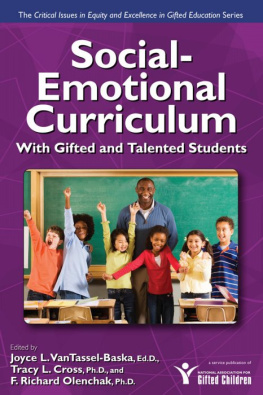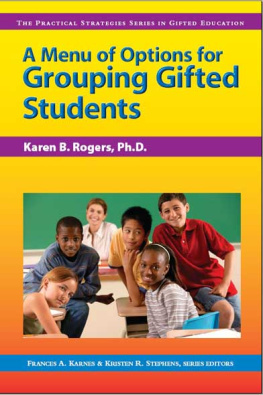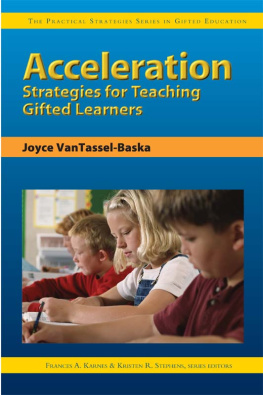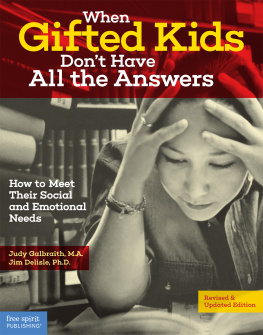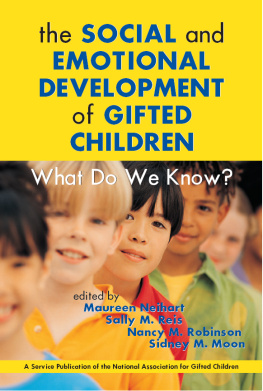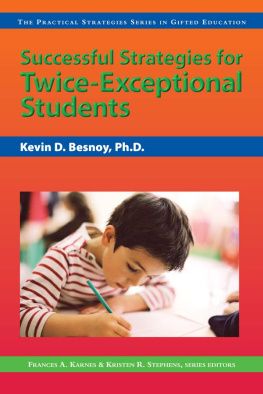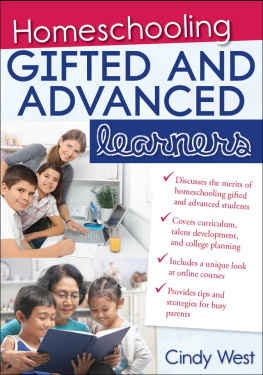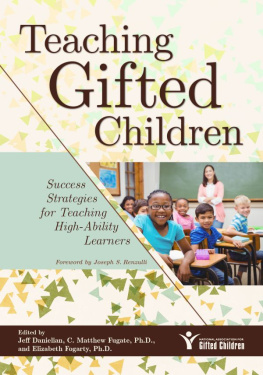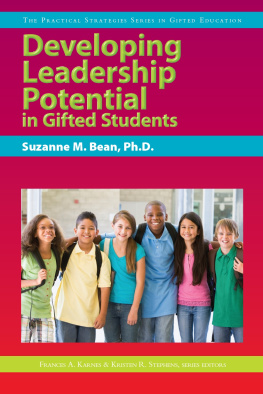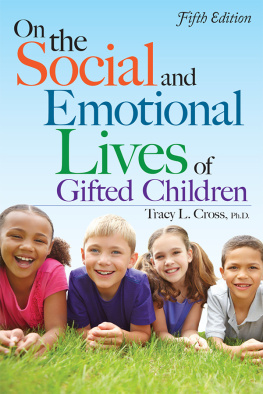The Critical Issues in Equity and Excellence in Gifted Education Series
Social
Emotional
Curriculum
With Gifted and Talented Students
Edited by
Joyce L. VanTessel-Baska, Ed.D.,
Tracy L. Cross, Ph.D.,
and F. Richard Olenchak, Ph.D.

Prufrock Press Inc.
Waco, Texas

Copyright 2009, the National Association for Gifted Children
Edited by Lacy Compton
Cover and Layout Design by Marjorie Parker
ISBN-13: 978-1-59363-511-4
ISBN-10: 1-59363-511-7
No part of this book may be reproduced, translated, stored in a retrieval system, or transmitted, in any form or by any means, electronic, mechanical, photocopying, microfilming, recording, or otherwise, without written permission from the publisher.
Printed in the United States of America.
At the time of this books publication, all facts and figures cited are the most current available. All telephone numbers, addresses, and Web site URLs are accurate and active. All publications, organizations, Web sites, and other resources exist as described in the book, and all have been verified. The authors and Prufrock Press Inc. make no warranty or guarantee concerning the information and materials given out by organizations or content found at Web sites, and we are not responsible for any changes that occur after this books publication. If you find an error, please contact Prufrock Press Inc.

Prufrock Press Inc.
P.O. Box 8813
Waco, TX 76714-8813
Phone: (800) 998-2208
Fax: (800) 240-0333
http://www.prufrock.com
Dedication
To my family, Lee and Ariel, who continue to support and inspire.
Joyce VanTassel-Baska
To Pam, Lawren, and those whose love supports me through trials of health and identity.
F. Richard Olenchak
Acknowledgements
I would like to acknowledge the support of Bronwyn MacFarlane for her assistance in the revision stages of this manuscript. Her work was deeply appreciated.
Joyce VanTassel-Baska
I would like to thank Jennifer R. Cross and A. Dawn Frazier for their invaluable assistance with this book.
Tracy L. Cross
I would like to thank Andrius Dzedulionis for his assistance in the development of this book.
F. Richard Olenchak
List of Tables
List of Figures
CHAPTER
Introduction
Joyce VanTassel-Baska
This book has been a long time in coming together. In 2003, a group of several of the contributors gathered in Houston for a weekend of discussion and planning under the leadership of Rick Olenchak, then president of the National Association for Gifted Children (NAGC). We worked diligently to produce outlines and then first drafts for several chapters. We also identified others whom we felt could make a strong contribution to the book. We continued to stay in touch by e-mail and critique each others work over the next year. We have now chosen to reenergize the project with a broadened group of contributors and an expanded editorship model as well. The book now represents a more timely focus on different curriculum directions that offer affective support. It also provides a strong contribution to our field on a topic often not discussedhow can teachers help gifted students develop their social and emotional selves in the context of standards and assessment-driven school environments?
The book comprises 12 chapters, each of which offers a unique perspective on social-emotional curriculum. What binds the book together is the powerful theme of meaning-making, in other words, helping gifted students make sense of the big ideas in life including their own identity and the processes by which personal growth and development occur. It is a book that has content that is valid for both educators and counselors; even though the processes may vary based on their areas of skilled training. Why do we feel the book is important enough to have in a series on equity and excellence? Because this book offers guidance and counsel to all who work with the gifted and gets to the heart of their concerns.
By working through the layers of self that we all bring to this thing called life, gifted students can come to know they are not alone, whether through reading about a protagonist in a novel suffering similar angst or a biography of an eminent individual who demonstrated similar struggles and came out on the other side. They can begin to express their emotions rather than repress them through the process of discussion or the engagement in the arts. They can come to understand their different selves as individuals and as individuals in various groups, realizing that they present distinctive selves based on context and relationships. They can face the problems that most gifted students encounter at some stage of their growing into early adulthoodconfronting perfectionism, developing important relationships, dealing with sensitivity and their own intensity, and channeling their concerns about the world into worthwhile service projects and careers. Yet, gifted students often cannot do these things unaided. They need a wise teacher or counselor who will guide them in the right direction, listen to their fears, and reassure and nurture them when they need support.
This book is intended to provide those wise friends and mentors with the support they need to do that work. The editors hope the chapters herein can sustain an ongoing program of socioemotional guidance throughout the school years, from kindergarten through high school. We hope that schools will realize the importance of providing a social-emotional curriculum and provide professional development for their teachers in this area, based on the Gifted Education Teacher Standards, passed by the National Council for Accreditation of Teacher Education (NCATE) in 2006, to ensure that all educators who work with gifted youth have core competencies in social and emotional areas of their makeup. The standards that follow in Table 1.1 offer a blueprint for such professional development that can be used along with this book.
Table 1.1
Standards for Preparation of Gifted Education Teachers Focusing on Social-Emotional Needs of Students
| Standard | Social-Emotional Knowledge and Skills |
| Standard 2: Development and Characteristics of Learners | K1: Cognitive and affective characteristics of individuals with gifts and talents, including those from diverse backgrounds, in intellectual, academic, creative, leadership, and arts domains. |
| Standard 3: Individual Learning Differences | K2: Academic and affective characteristics and learning needs of individuals with gifts and talents and disabilities. |
| Standard 5: Learning Environments and Social Interaction | K2: Influence of social and emotional development on interpersonal relationships and learning of individuals with gifts and talents.
S1: Design learning opportunities for individuals with gifts and talents that promote self-awareness, positive peer relationships, intercultural experiences, and leadership.
S2: Create learning environments for individuals with gifts and talents that promote self-awareness, self-efficacy, leadership, and lifelong learning.
S3: Create safe learning environments for individuals with gifts and talents that encourage active participation in individual and group activities to enhance independence, interdependence, and positive peer relationships.
|

